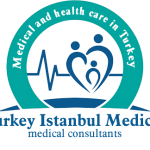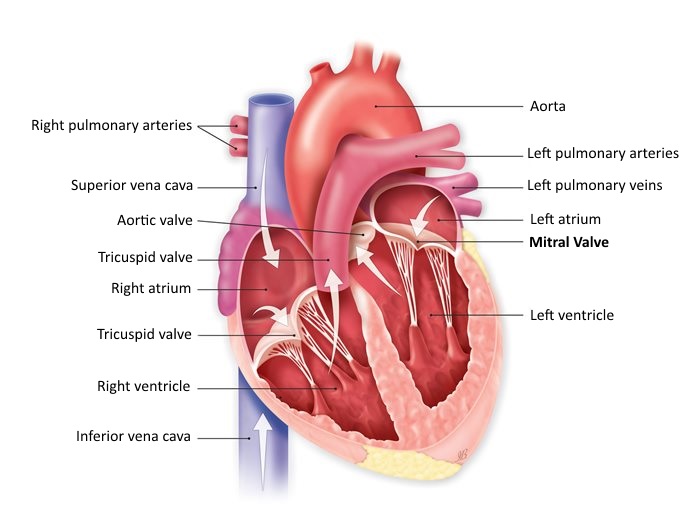What is Mitral Valve? And What Are The Diseases?
The mitral valve is a valve located between the left atrium and left ventricle of the heart and allows one-way blood flow. This cap has two leaves and its leaves are attached to the ventricle muscle with threads like parachute threads.
The mitral valve is basically formed by the union of 4 structures:
- Cover leaflets
- Cover ring (annulus)
- Papillary muscles (muscles that provide the movement of the lid)
- Chordea tendinae (the filaments that connect the muscles to the leaflets)
What Does The Mitral Valve Do? How Does İt Work?
When the heart relaxes, the mitral valve opens and clean blood from the lungs in the left atrium passes through the mitral valve and fills the left ventricle. When the left ventricle contracts to pump this blood through the aorta to the body, the mitral valve closes, preventing this blood from returning to the left atrium, and all the blood is pumped throughout the body.
What are Mitral Valve Diseases?
-
What is Mitral Stenosis?
The mitral valve is located between the left atrium and the left ventricle, consists of 2 leaflets (bicuspid). The blood filled with oxygen in the lungs comes to the left atrium via the pulmonary veins, and from there it empties into the left ventricle by passing through the mitral valve. Then the left ventricle contracts and throws the blood into the aorta to distribute it throughout the body. At this time, the mitral valve closes to prevent blood from returning to the left atrium and the aortic valve opens. Normally, the mitral valve area is 4-6 cm2. If valve stenosis occurs (in some cases described below), the valve area narrows, making it difficult for blood to drain from the left atrium into the left ventricle.
What are The Causes of Mitral Stenosis Disease?
Mitral stenosis (MD) is almost always the result of rheumatic heart disease. This disease disrupts the structure of the lids and causes deformity, hardening, calcification and adhesions on the lid tips, causing the lids to not be able to be opened fully. Very rarely, it can be congenital.
What are The Symptoms of Mitral Stenosis Disease?
- Shortness of breath,
- Heart Palpitations,
- Rhythm Disorder,
- Chest Pain,
- Fainting,
- Swelling in the legs,
- Vomiting blood and being unable to lie down
May be signs of heart valve disease.
Many of these symptoms usually occur at the same time. Identifying the symptoms of heart valve disease is important in the surgical decision-making process.
What is The Treatment of Mitral Stenosis Disease?
As long as the eyelid surface does not fall below 2.5 cm2, there is nothing to complain about. Only preventive antibiotics are given at this stage. Sodium restriction and diuretics are used to relieve or reduce the shortness of breath that occurs when the valve area is narrowed. Medication intervention is required when the surface is less than 1.5 cm2.
Two methods are used for this purpose:
-
Mitral Balloon Valvuloplasty (MBV):
First assess the patient’s suitability for this approach. This can be done if the physical properties of the valve are suitable and there is no clot in the left atrium.
In this method, a special balloon is used to expand the valve by reaching the inguinal vein without surgery. For this, it is sufficient for the patient to stay in the hospital for a few days.
-
Surgical:
Surgery is required if the valve is not suitable for MBV. In this method, if the lid is not very deformed, its adhesions are opened and expanded. However, if its structure is very deteriorated, it is replaced and an artificial valve (prosthesis) is placed.
-
What is Mitral Valve Insufficiency?
Mitral valve regurgitation is a heart valve disease in which the mitral valve between the chambers on the left side of the heart does not close completely and blood flows backwards through the valve.
In this case, the blood cannot move in the direction it should and leakage occurs. The severity of the leak gives information about the course and severity of the disease. If the severity of the leakage is high, enough blood cannot go to the heart and body. This causes the person to feel tired and short of breath.
Mitral valve regurgitation results from a problem with the structure of the heart and the direction of blood flow. In order for oxygen-rich blood to be pumped by the heart to the body, blood must pass from the left atrium to the left ventricle. The tissue that provides the passage between these two chambers is called the mitral valve or mitral valve. This valve failure is also caused by the problem in this valve.
What are The Causes of Mitral Valve Insufficiency?
-
Rheumatic Heart Disease:
It is rare for rheumatic heart disease to cause MR alone. More often, mitral stenosis is also found together in various degrees.
-
Mitral Valve Prolapse:
It is one of the common causes especially in developed countries.
-
Conditions that Expand the Left Ventricle:
Mitral valve margins are between left ventricle and left atrium. The enlargement of the left ventricle also enlarges the periphery of the valve.
Thus, although there is no problem in the lid tissue, since the circle to which the lid is attached expands, the lids cannot come together when they are closed and MR occurs. Any cause of left heart failure can therefore also cause MR: hypertension, heart attack, cardiovascular disease, aortic insufficiency, aortic stenosis, cardiomyopathy, etc.
-
Congenital (Congenital):
Congenitally, there may be a structural defect or deficiency in the mitral valve or the structures to which it is attached.
-
Cap Tear Or Breakage Of The Threads (Cord) Holding The Cover:
Blunt blows to the chest, heart attack, endocarditis.
-
Calcification of the Mitral Valve Attachment (Mitral Annulus Calcification):
It is common in the elderly and its incidence increases with age. However, serious MR is rare.
What are The Symptoms of Mitral Valve Insufficiency?
Mitral valve regurgitation can sometimes continue for years without showing any symptoms. They usually progress slowly. Rarely, acute mitral valve regurgitation may occur. It can occur suddenly and cause sudden symptoms. A common symptom of this valve regurgitation is patient fatigue.
Other symptoms can be listed as follows:
- Heart palpitations. A palpitation, especially when you lie on the left side, may be a sign of mitral valve insufficiency.
- Arrhythmia (Irregular heartbeat)
- Heart murmur
- Shortness of breath that may increase in the lying position
- Rapid breathing
- Cough
- Edema manifested by swelling, especially in the wrists and ankles
- Chest pain
How is Heart Valve Failure Diagnosed?
The main reason for the occurrence of mitral valve regurgitation is damage to the mitral valve. This situation may have occurred for the following reasons.
-
Congenital Heart Defects:
Congenital heart diseases can be related to the general structure of the heart or sometimes to the heart valves.
-
Heart Attack:
The severity of a heart attack can damage the muscles of the heart. If the injured muscles are around the mitral valve, mitral valve insufficiency may be seen.
-
Mitral Valve Prolapse:
It is also known as mitral valve prolapse or collapse. There is a difficulty in the function of the mitral valve and this can cause mitral valve regurgitation.
-
Rheumatic Fever:
It occurs as a result of a throat infection caused by a type of bacteria. It is also known as cardiac rheumatism. Rheumatic fever can also damage heart valves. This can occur early in life or later in life.
-
Cardiomyopathy:
It is a problem of thickening of the heart muscle. The heart has trouble pumping blood and the valves can be damaged.
- Cardiac membrane (endocarditis) infections
- Damaged tissues in the heart
- Radiotherapy applications applied to the chest area
Treatment
In the treatment of mitral valve regurgitation, the degree of this valve regurgitation is of great importance. In moderate and mild mitral valve regurgitation, drug therapy is given to relieve the load on the left ventricle. Salt restriction is recommended by administering diuretic drugs at the same time. In severe cases of mitral valve regurgitation, surgery can be performed in addition to drug therapy, taking into account the patient’s symptoms.
Surgical repair of the heart valve or replacement of the heart valve is performed. If the patient has a high risk of undergoing surgery, procedures to reduce heart failure are performed. However, blood thinners are given to prevent clot formation in the patient.
With the continuous development of technology, closed surgeries are performed. Minimally invasive surgical method is used in the treatment of mitral valve regurgitation. The heart valve is replaced or repaired with an operation performed on the lower end of the chest, chest side wall or armpit.
In other words, with the continuous development of technology, heart surgeries are also performed closed and very successful results are obtained.
Pay Attention to These About Mitral Valve Insufficiency!
Some lifestyle changes have a key role in relieving the symptoms of problems such as heart disease and mitral regurgitation and preventing their progression.
These changes can be listed as follows:
A Healthy Diet:
- In order to prevent heart diseases, you should choose a healthy and balanced diet model that will be good for the cardiovascular system.
- Remember that the most accurate nutrition plan and weight control for you can only be provided by a dietitian who is an expert in the field.
- Avoid fast foods, refined sugars, trans fats and packaged foods. Instead, include healthy oils such as olive oil or fish oil, whole grain products, vegetables and fruits, and raw nuts.
Exercise:
- Incorporate walking and a sport that suits you in consultation with a health professional.
- Stay away from alcohol, smoking and harmful habits. Choose a stress-free life.
- Don’t forget to have regular health check-ups.
If you have a heart problem or suspect mitral valve insufficiency, do not neglect to make an appointment with the cardiovascular diseases department and be examined by a specialist cardiologist.

